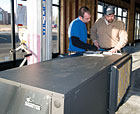
A 48,000 Btu water-to-air geothermal system is installed at a light commercial facility in Ohio.
Interest in renewable energy sources such as solar and wind power is growing, due to the higher cost of fossil fuels as well as the new administration on Capitol Hill. This trend is also benefiting another renewable energy source - geothermal - that is growing in popularity in both residential and commercial markets.
The commercial market has been a bit slower to adopt geothermal technology, but that could all change this year with the passage of the Federal Economic Stimulus Bill, which became law in February. This legislation defines geothermal heat pumps (GHPs) as energy property and provides a new 10 percent investment tax credit (or grant) to businesses that install GHP systems, as well as a five-year depreciation period. A 50 percent bonus depreciation is also available for GHP systems installed in 2008 or 2009, which makes geothermal technology even more attractive to building owners and operators.
These incentives from the government are in addition to the biggest benefits enjoyed by commercial GHP users: Lower maintenance bills and energy costs that are typically 30-50 percent lower than buildings using conventional heating and cooling equipment. Reduced energy use also lowers the demand on utilities, which then do not need to build new facilities to serve their customers.
SALES TRENDING UP
Most manufacturers noted that sales of commercial geothermal equipment are up - way up - and they foresee that trend continuing in the future. “Our commercial sales in 2008 increased more than I anticipated - approximately 30 percent,” said Michael Albertson, vice president of commercial sales and marketing, WaterFurnace International Inc., Fort Wayne, Ind.Albertson attributes the increase in commercial sales to building owners in specific markets, such as schools, the military, government office buildings, and commercial office buildings that are not changing hands. “They are realizing the advantages of being able to save between 40 and 60 percent in operating costs and drastically reduce their maintenance costs by installing a geothermal system.”
The geothermal market has doubled in the last three years and now represents the fastest growing segment of our commercial business, said Dan Ellis, president, ClimateMaster, Oklahoma City, Okla.
“The new federal programs are really going to be a huge boost to the commercial side. If you look at the new tax credits and bonus depreciation, it’s possible to get 50 percent of the initial investment in a geothermal system back in five years, in addition to the energy savings. Compare that to a conventional heating and cooling system installation with a 39-year depreciation, and you can see that it’s a tremendously good deal right now.”

The mechanical room at Fort Sill was recently outfitted with geothermal water-to-water equipment.
The commercial geothermal business has been growing steadily for the last 10 years, noted Robert Koschka, geothermal systems engineer, FHP Bosch Group, Fort Lauderdale, Fla., but he attributes the recent spike to Leadership in Energy and Environmental Design (LEED) and American Society of Heating, Refrigerating and Air-Conditioning Engineers (ASHRAE) awareness. “With the recent return of green incentives to the HVAC industry, I suspect we’ll see a larger acceptance of the geothermal concept. I’ve watched the geothermal industry steadily evolve for 25 years, and I think we’ll see upward growth during the next five years.”
Robert Sycks, director of sales, Heat Controller Inc., Jackson, Mich., agreed, noting that commercial installations continue to rise and the forecast is for that rise to continue. “About 50 percent of our water-source business is in commercial applications. The higher cost of utilities has given renewed interest in these systems, and interest will continue to grow with the desire to install greener technology. The federal government has supported [the technology] with favorable tax incentives and accelerated depreciation on new installations. With all these factors, the outlook for commercial installation in new and retrofit applications is reaching a whole new level of awareness.”
The future is definitely bright for commercial geothermal installations, said John Kelly, executive director, Geothermal Heat Pump Consortium, Washington, D.C. “Right now, geothermal is about 1 percent of the overall HVAC market, and I’ll bet in five years that could go up to 5 percent. That may not sound like a lot, but realistically, that would be an increase of 500 percent, and that’s the kind of growth that I see on the commercial side.”

Commercial installations, such as this ClimateMaster water-to-air geothermal application, are gaining popularity, thanks to tax credits and faster depreciation periods.
POTENTIAL OBSTACLES
With all the federal incentives available, more commercial building owners may be looking into geothermal options. While that’s great news for the industry, a lack of qualified personnel who can design and install the systems may hinder the widespread use of geothermal equipment.“Designing these systems requires a different expertise that’s not readily available out there yet,” said Ellis. “That’s our biggest hurdle - training more people to use the new software tools that are available. You have to use software that models the energy flow in and out of the earth over the years, so you can achieve an energy balance in your storage. Not everyone out there knows how to do this yet.”
Albertson agreed, noting that when a building owner requests a geothermal system, the architect is often asked to find an engineer with experience designing geothermal systems for the commercial market. “In some cases, when that experience is not available, the recommendation is to install more conventional systems.”
Finding these experienced individuals can be difficult, but it’s absolutely necessary. As Sycks noted, the design of a commercial ground loop takes special planning and a certified commercial designer is usually involved on the design process. “General residential installation practices are not followed on commercial applications, where exact engineering data is required.”
Koschka agreed, stating that the accuracy of the building load is the biggest challenge when sizing a commercial ground loop. “If you err on the building load, you’ll err on the size of the loop field.”
In areas of the country that have not seen much geothermal activity, it can also be a challenge to find qualified drilling and excavation contractors. “Our growth is really limited by the infrastructure we have, which includes the drill rigs and the experienced people who design the systems and put the pipe in the ground,” said Ellis.
“We can crank out boxes at the factory, but there are only so many drill rigs in the country. It takes time to train people, and it takes time to buy the machines, because they’re expensive. These tax incentives go until 2016, so if we can start ramping up the infrastructure, I think we’ll be able to maintain double digit growth for the entire period of those incentives.”
One way to increase the number of qualified people in the field who can design geothermal systems is to educate future engineers while they’re still in college. Kelly noted that the Geothermal Heat Pump Consortium is working to do just that.
“If every college engineering junior had to take a course in geothermal design, then in 10 years, everyone would know about it. If you look at a standard mechanical engineering curriculum at a major university, they probably devote less than one hour to talking about geothermal heat pumps.”

The geothermal market has doubled in the last three years and now represents the fastest growing segment of ClimateMaster’s commercial business.
BOUNTIFUL BENEFITS
While there are still some hurdles to overcome in the commercial geothermal market, manufacturers are certain the benefits of installing these systems will far outweigh any inconveniences. As Albertson noted, “The return on investment on a commercial geothermal system can be anywhere from five to 10 years. Geothermal also offers increased system longevity, with an average life span of 24 years and a ground loop with a half-life of 200 years. Many pipe suppliers or manufacturers offer 50-year warranties on their ground loop material.”Other benefits to installing a geothermal system include zoned space conditioning with individual space control, reduced floor area for mechanical equipment, and multiple options for architectural roof design since the HVAC system can be installed completely indoors (excluding the loop field), said Koschka.
He added that the dollar savings will vary by geographic location and the cost of electricity and natural gas, but “most commercial geothermal applications should see a 10-30 percent savings compared to a comparable system designed to ASHRAE 90.1 standards. There have been some commercial buildings that have seen savings greater than 50 percent. A typical simple payback comparison is usually between two and seven years.”
While space for the loop field can sometimes be a consideration in geothermal applications, there are ways to overcome these issues, said Sycks.
“There is no limit to the type of buildings that can utilize a geothermal installation. Schools certainly offer great opportunities for geothermal installation, because they usually have adequate space for the geothermal loop field to be installed. However, most commercial geothermal installations are done with vertical loop fields, where a vertical bore hole is drilled and plastic piping is inserted into the hole and the water solution is circulated through the pipe to exchange heat. The advantage of vertical systems is they require less space and the area above the loop field can be used for other activates like playgrounds or parking areas.”
Another option that may be used for commercial buildings that do not have a lot of land available for a loop field is to employ a hybrid system. As Koschka noted, the hybrid loop design originated in Southern states and utilizes a partial ground loop that matches the heating requirement and a tower (or rejecter) to discharge heat that doesn’t need to be saved.
Ellis stated the hybrid system reduces costs because the loop field is sized to take care of a specific heating load. “This reduces the size of the loop field, because it provides enough heat for winter, and instead of storing up any excess heat, a heat rejecter throws it away. Putting energy into the earth makes the most sense when you need that energy back out during the winter.”
There is definitely a lot of excitement in the geothermal industry these days. The green movement has increased awareness in highly-efficient GHPs, and the generous subsidies offered by the federal government are leading more commercial building owners to look at geothermal as a viable option for their properties. The result is there may be no better time to venture into the world of geothermal - for contractors and building owners.
Sidebar: Reduced Energy
According to a recently released report, Oak Ridge National Laboratory estimates that residential and commercial GHPs have the potential to reduce non-renewable primary energy consumption in buildings by 3.4 to 3.9 quads annually by the year 2030. Since buildings currently consume about 40 quads of non-renewable primary energy annually, and are projected to consume 49.5 quads in 2030, GHPs have the potential to offset about 35-40 percent of the projected growth in building energy consumption between now and 2030.Publication date:05/04/2009






